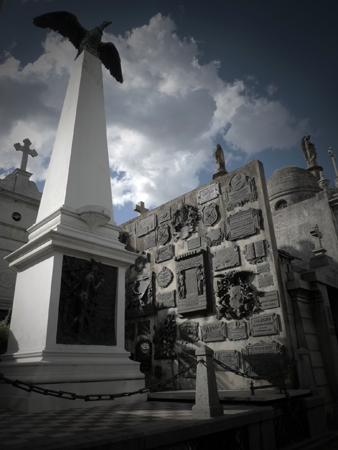
As the only occupant of Recoleta Cemetery marked with signposts, Sarmiento is widely recognized as one of the most important figures in Argentine history:
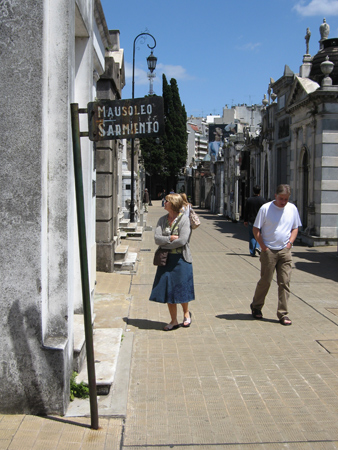
Born in 1811 while Argentina struggled for independence, Domingo Sarmiento spent his early years voraciously reading & studying. It would set the tone for his life. By the age of 15, he founded a school in his native province of San Juan… all students were naturally older than he was at the time.
Due to civil war & local caudillo Facundo Quiroga, Sarmiento fled in exile to Chile in 1831 where he continued his educational activities. That period was spent between marriage, founding the Universidad de Chile, running a newspaper, & being sent on behalf of the Chilean government to the United States to study its primary education system.
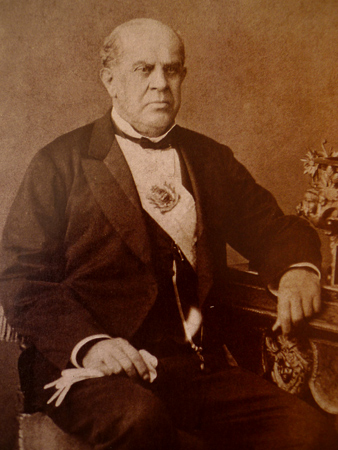
Sarmiento returned to Argentina 20 years later as an authority in education. Anti-Rosas to the core, he later aligned with Bartolomé Mitre while serving as Senator. Accompanying General Wenceslao Paunero to the Cuyo region, Sarmiento governed his native province of San Juan then returned to the U.S. as Argentina’s ambassador. Unfortunately his adopted son was killed in the War of the Triple Alliance while he was away. Back home in 1868 & under no political party, Sarmiento was elected President with Adolfo Alsina as his running mate. After one term in the Casa Rosada, he continued to serve Argentina in number of governmental & educational posts.
Late in life, Sarmiento moved to Asunción for health reasons. He passed away on Sept 11, 1888, & that day is now commemorated as Teacher’s Day. The most accessible portrait of Sarmiento can be found on an older version of the 50 peso bill, but he was also the subject of one of the most publicized death portraits in Argentine history. Those portraits were commonly used to mark important events & released to the press. Sarmiento “posed” for this photo a few hours after his death surrounded by objects of daily use… including his chamber pot:
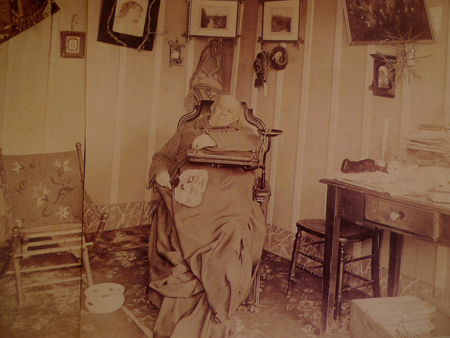
Sarmiento was then brought by boat to Buenos Aires & buried in Recoleta Cemetery. In a crypt designed by Italian sculptor Victor de Pol, the base of the obelisk contains two reliefs: one of Mercury (Roman god of communications) & Sarmiento with children holding books. The French phrase “on ne tue point les idées” was inscribed by Sarmiento on a stone in the Andes Mountains when he fled to Chile: “One never kills ideas”:
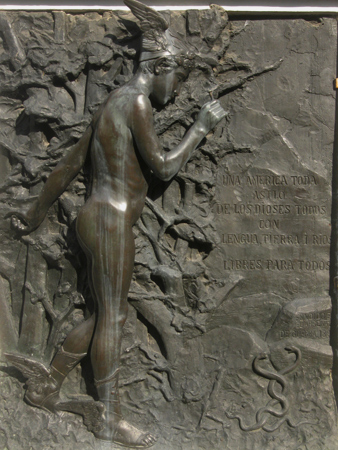
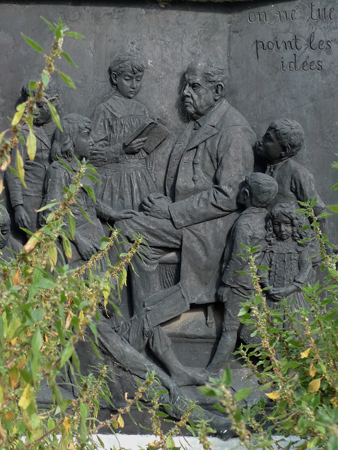
Plaques once covered the obelisk itself (as seen below) but were later placed on the side wall when they outnumbered available space. The bust has also been removed. Hidden behind a potted plant is a reminder that Sarmiento once participated in the Grand Lodge of Argentina:
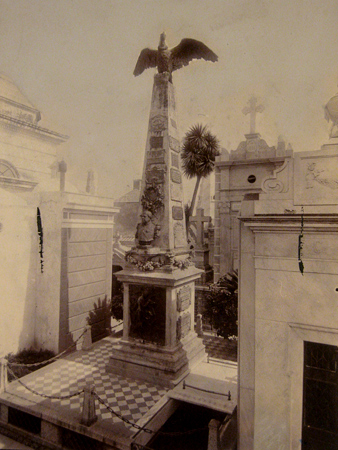
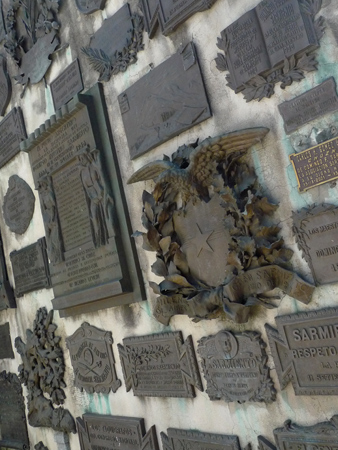
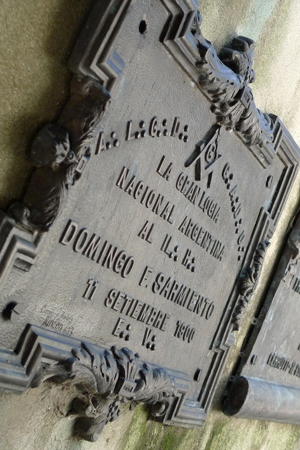
A condor, native to the Andes Mountains & symbolic of Sarmiento’s contributions to Chile & Argentina, crowns the obelisk. At the bird’s feet is a bit of barely legible, cursive text. It reads Civilización y Barbarie, the title of Sarmiento’s definitive work against Quiroga:
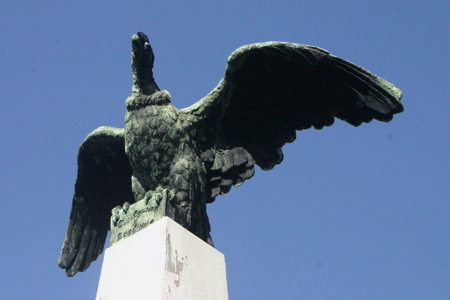
Of course Sarmiento was no saint & displayed some negative traits of his time: racism & a bit of an addiction to power. But historians have chosen to focus on the positive. This tomb was declared a National Historic Monument in 1946.
felicitaciones sigan asi ,aunque no siempre dejo mensajes siempre leo la pagina ,aprendo mucha HISTORIA y de paso mejoro mi ingles ,sigan adelante y felicitaciones
Tengo entendido que él mismo diseñó su tumba, de acuerdo a sus ideas masónicas. También diseñó la de su hijo, Dominguito, que murió en 1867 en la batalla de Curupaití en la guerra del Paraguay.
Hola Paula – Fue Victor de Pol que diseñó la tumba de Sarmiento según una biografia del escultor escrito por Edgardo J. Rocca. Puede ser que Sarmiento diseñó la cripta del hijo pero no leí nada para confirmarlo.
En el libro Cuyano Alborotador dice que Sarmiento deseaba una hiedra sobre su tumba. Parece que nadie cumplió su deseo.
Hay varias versiones, inclusive una que cuenta que Sarmiento cultivaba una hiedra para su propia tumba. Vaya a saber si lo hizo o no. Igual me parece que quedó con un lindo lugar para descansar en paz. Saludos!
Hey, I hate to be *that* guy but “on ne tue point les idées” means “one never kills ideas”. Not quite the same thing..
Hey – Definitely not a problem… text corrected! If it weren’t for reader contributions, I’d certainly have more errors 🙂 And I need to add a pic of the latest Masonic plaque. This is a never-ending blog…
[…] Oh, and the grave that we thought was hers, was actually the person that the sign pointed to, one Domingo Faustino Sarmiento, a very notable character indeed in the history of […]
[…] Argentina to hand out bibles and became friends with Sarmiento (President from 1868 to 1874; click here to find out more). That encounter made my day. Today, by the way, is my blog’s third birthday. […]
“On ne tue point les idées” means in fact “Ideas are not killed”. The English language is a master of the passive form. Some add: Barbarians, ideas are not killed! Sarmiento was on the flight of barbarians, who wanted to kill him (because of his progressive ideas?). In either case, he has got his point. His ideas have not been killed, he was the father of education in Argentina. While he was President, a census was performed and proved, that 75 % of Argentina’s population (of a total of 1,8 million) was illiterate. One generation later, everybody could read and write. His bust has been restored in the meantime, I am always there, when I guide guests through Recoleta cemetery.
Thanks for your comment, Hugo. Seems like everyone has their own translation, but at least the same point comes across. His ideas could not be killed, & it’s remarkable that at the time Argentina had more progressive policies in education than many countries in Europe… most everyone attributes that to his time in the US. I’m glad to hear that his bust has been restored!
Hola,se que su hija Ana Faustina descansa en la cripta con el,pero quisiera saber si alguno de ustedes sabe si su yerno Julio Belin fallecido en Chile y sus ñietos tambien estan sepultados allí,ya que de sus 6 ñietos solo el mayor tubo decendencia y en la página genealoguiafamiliar.net dice que todos estan en la Recoleta pero no se si todos en este mismo mausoleo.
Estudio turismo y esta es una de mis páginas de cabezera a la hora de buscar informacion.Esta barbara, sigan así.
Hola Javier – Gracias por el comentario… nos encanta investigar el cementerio y no tomar por hecho lo que mucha gente dice es verdad 😉 Creo que la única manera de saber si Belín está ahí o no es ir a la oficina con su fecha de muerte. Claro, cuando pase el confinamiento y reabra el cementerio. En las miles de veces que fui, no me acuerdo ver otro mausoleo con el apellido Belín. Lo cual, supongo que estará en la tumba de Sarmiento. Pero verificálo con la administración para estar seguro. Saludos!